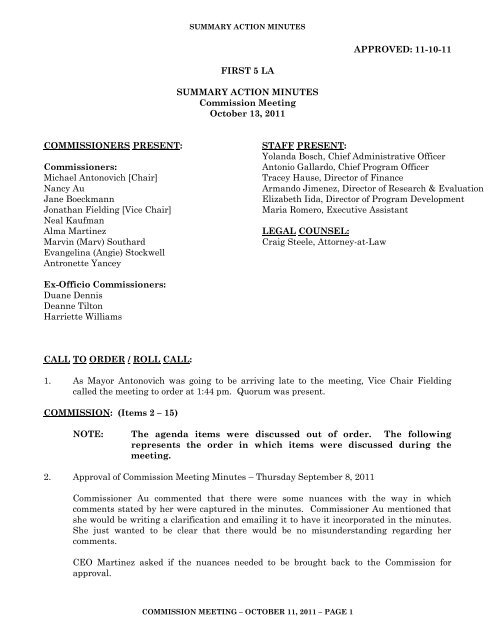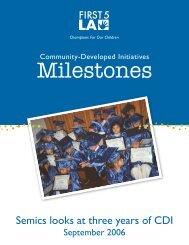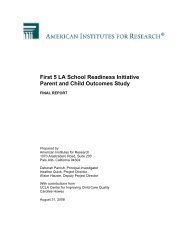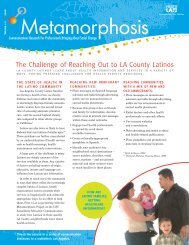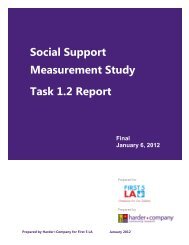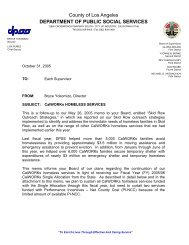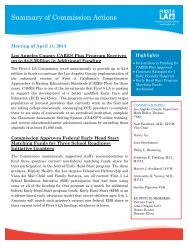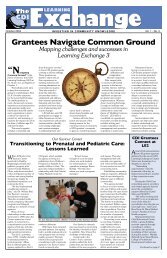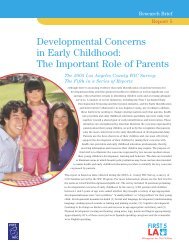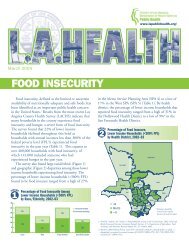Item 02 Commission Minutes 10-13-11 APPROVED.pdf - First 5 LA
Item 02 Commission Minutes 10-13-11 APPROVED.pdf - First 5 LA
Item 02 Commission Minutes 10-13-11 APPROVED.pdf - First 5 LA
You also want an ePaper? Increase the reach of your titles
YUMPU automatically turns print PDFs into web optimized ePapers that Google loves.
SUMMARY ACTION MINUTES<strong>APPROVED</strong>: <strong>11</strong>-<strong>10</strong>-<strong>11</strong>FIRST 5 <strong>LA</strong>SUMMARY ACTION MINUTES<strong>Commission</strong> MeetingOctober <strong>13</strong>, 20<strong>11</strong>COMMISSIONERS PRESENT:<strong>Commission</strong>ers:Michael Antonovich [Chair]Nancy AuJane BoeckmannJonathan Fielding [Vice Chair]Neal KaufmanAlma MartinezMarvin (Marv) SouthardEvangelina (Angie) StockwellAntronette YanceySTAFF PRESENT:Yolanda Bosch, Chief Administrative OfficerAntonio Gallardo, Chief Program OfficerTracey Hause, Director of FinanceArmando Jimenez, Director of Research & EvaluationElizabeth Iida, Director of Program DevelopmentMaria Romero, Executive AssistantLEGAL COUNSEL:Craig Steele, Attorney-at-LawEx-Officio <strong>Commission</strong>ers:Duane DennisDeanne TiltonHarriette WilliamsCALL TO ORDER / ROLL CALL:1. As Mayor Antonovich was going to be arriving late to the meeting, Vice Chair Fieldingcalled the meeting to order at 1:44 pm. Quorum was present.COMMISSION: (<strong>Item</strong>s 2 – 15)NOTE: The agenda items were discussed out of order. The followingrepresents the order in which items were discussed during themeeting.2. Approval of <strong>Commission</strong> Meeting <strong>Minutes</strong> – Thursday September 8, 20<strong>11</strong><strong>Commission</strong>er Au commented that there were some nuances with the way in whichcomments stated by her were captured in the minutes. <strong>Commission</strong>er Au mentioned thatshe would be writing a clarification and emailing it to have it incorporated in the minutes.She just wanted to be clear that there would be no misunderstanding regarding hercomments.CEO Martinez asked if the nuances needed to be brought back to the <strong>Commission</strong> forapproval.COMMISSION MEETING – OCTOBER <strong>11</strong>, 20<strong>11</strong> – PAGE 1
SUMMARY ACTION MINUTESVice Chair Fielding responded that if the nuances did not significantly change the minutes,then he saw no need for the <strong>Commission</strong> to have to approve the minutes again.<strong>Commission</strong>er Au stated that her comments were in the context of the budget requirementsin terms of the structure of the budget as it was being constructed by the department. Forher, there was a contradiction in terms of the community investment operations. The<strong>Commission</strong> really needed to take a better look in terms of how the <strong>Commission</strong> goes aboutconstructing that particular area or that particular department’s budget. From anadministrative perspective, when staff is being directed to construct a budget, a generalrequirement needs to come about how this will be done.<strong>Commission</strong>er Au felt that because of the unique nature of the community investment area,she had concerns that particular requirement was going to restrict this area from actuallydoing the work. Toward the end of that conversation, the <strong>Commission</strong> did refer this issueto the Executive Committee, who was looking at the whole budgeting process. This wasconversation that she recalled.Vice Chair Fielding stated that if there was any disagreement after <strong>Commission</strong>er Ausubmitted her change, then that particular issue could be brought back to the <strong>Commission</strong>for further discussion at the next meeting.M/S(Marv Southard / Jane Boeckmann)<strong>APPROVED</strong> AS MODIFIED5. Chief Executive Officer’s RepotIn addition to the written report, the following items were highlighted:• Panel Discussion on Health Care Reform & Childhood Obesity: On September30, <strong>First</strong> 5 <strong>LA</strong>’s Policy Department held a successful panel discussion on health carereform and childhood obesity which drew a crowd of close to 80 people and featured anumber of expert speakers. Two Assemblymembers joined the discussion as panelists—Felipe Fuentes of Pacoima, Chair of the Appropriations Committee, and RogerHernández of Baldwin Park, Assistant Majority Whip. Both spoke about their bills,which aimed to improve children’s health.• Legislative Update: Governor Brown signed a number of bills last week that <strong>First</strong> 5<strong>LA</strong> has been tracking, including three of the four bills that had been discussed by thelegislators on our panel. One of the bills described at the event and supported by ouradvocacy efforts was AB 185 by Assemblyman Roger Hernández. This new lawaccelerates one of the provisions of the Affordable Care Act requiring that insurancecompanies provide maternity coverage on individual plans. Insurance companies can nolonger deny women maternity care coverage, which will mean healthier birth outcomesfor women who lack employer based insurance plans.• Sweetened Beverages Policy Brief: The new policy brief on sugar sweetenedbeverages was released at the panel discussion. The report is the product of acollaboration with the California Center for Public Health Advocacy. It illustrates thedramatic increase in children’s consumption of sugary beverages over the decades andhow this directly impacts childhood obesity.COMMISSION MEETING – OCTOBER <strong>11</strong>, 20<strong>11</strong> – PAGE 2
SUMMARY ACTION MINUTES• State Budget: With regard to the state budget, the news continues to be somber.Everyone is patiently waiting to see what is going to happen with AB 99. The judge isset to make a decision by the end of November.<strong>Commission</strong>er Stockwell referenced the update on Best Start Communities that wasreported in the CEO Report. She requested that percentages be provided for parent andcommunity agency participation for each of the meetings held in the Best StartCommunities. Her wish is that there be more parent participation at the communitymeetings than agencies.CEO Martinez commented that she would ensure that the reporting be consistent. She alsoreported that she had just completed a series of meetings with the Best Start Communitiesstaff. They are all making a very concerted effort to make sure that a majority of the peopleat the meetings are parents. Staff is very excited because they have been doing trainingwith parents to make them feel welcome and assuring them and empowering them thatthey have an equal voice at the table. From experience, once parents are more confident,they become the strongest advocates in the groups regardless of how long a CBO has beenin a community or regardless of how long they have been providing a particular service.The goal of Best Start Communities is to empower parents and the staff is doing awonderful job in making sure that the parents’ voice is heard in these communities.<strong>Commission</strong>er Stockwell asked if these meetings were working sessions for parents, notjust big functions. CEO Martinez responded that the meetings were working sessions.These working sessions provide an opportunity for staff to meet almost one-on-one withparents. CEO Martinez said that these meetings were trying to explain to the parentsexactly what is the intent of Best Start Communities, how parents can play a role in it, andwhy it is important for parents to be there. These meetings are about staff having anopportunity to meet with parents and for parents also to get to know each other.<strong>Commission</strong>er Au commended the Best Start Communities staff for continuing the workafter a significant restructuring. She also commended the leadership for continuing thework and avoiding delays in the process and implementation.<strong>Commission</strong>er Kaufman suggested presenting the information on the community meetingsusing a table format for easier reading.<strong>Commission</strong>er Tilton asked for a summary sheet to be provided on the outcomes of the billsthat <strong>First</strong> 5 <strong>LA</strong> is tracking. (NOTE: <strong>Commission</strong>er Tilton was provided with thisinformation following the meeting.)3. Approval of Monthly Financials – August, 20<strong>11</strong>M/S (Nancy Au / Angie Stockwell)<strong>APPROVED</strong> AS RECOMMENDED9. Approval of the FY 20<strong>11</strong>-12 Maximum Administrative Cost Percentage of 2.9%Vice Chair Fielding commented that a policy decision was made by the <strong>Commission</strong> at theJune meeting which placed a five percent cap on administrative funding. This does notCOMMISSION MEETING – OCTOBER <strong>11</strong>, 20<strong>11</strong> – PAGE 3
SUMMARY ACTION MINUTESmean that overall spending is capped at five percent for the <strong>First</strong> 5 <strong>LA</strong> staff because theyare two components: (1) the programmatic component where there are direct expendituresrelated to approved programs, and (2) the core administrative component which is financial,human resources, research & evaluation, and general administrative support.Without the policy taken together, the sum of the fixed staffing expenditures for the threecategories (programs, research & evaluation, administrative support) is about $15 millionor approximately eight percent of the projected $177 million programmatic budget the<strong>Commission</strong> approved. If not everything is spent that has been projected, this would beunusual if done, then the fixed administrative staffing costs would exceed eight percent ofthe direct costs in relation to a drop in programmatic expenditures. For example, in the20<strong>10</strong>-20<strong>11</strong> annual report which will be considered under <strong>Item</strong> 7 on page 63, line 52,<strong>Commission</strong>ers will note that the administrative expenditures as a percentage of the totalprogrammatic expenditures of that fiscal year was <strong>11</strong> percent, which is quite substantial.Vice Chair Fielding further commented that these figures need to be kept in mind. He alsoadded that projected revenue is estimated between $90 and $95 million in the future. If thesame level of administrative core support is maintained, the <strong>Commission</strong> would be over thefive percent, taking away the programmatic piece because the projected revenue is roughlyhalf of this year’s approved budget. Over time, attention will need to be given to makingsure that the <strong>Commission</strong> remains within the five percent cap and that it is consistent inthe categories that are placed within this five percent as opposed to those categories thatare placed in the programmatic side of the budget.<strong>Commission</strong>er Dennis asked if there was an administrative threshold that was decided bythe <strong>Commission</strong>. He said that he did not understand the basis of the conversation.Vice Chair Fielding stated that the <strong>Commission</strong> has adopted a five percent cap for coreadministrative expenses. What was problematic was the differentiation between centralexpenditures from those that were specifically related to a program. For example, the BestStart Communities staff should not be considered a core administrative expense. Thisshould really be under the Best Start Communities budget. <strong>Commission</strong>ers are only tryingto make this clear. But, also in thinking ahead, a maximum administrative cost percentageof 2.9 is below five percent. However, in looking at what is projected to be spent this year,the administrative costs would exceed five percent.Director Hause commented that the recommended maximum administrative costpercentage of 2.9 is based on budgeted numbers for operations and programmatic costs forFY 20<strong>11</strong>-12. The maximum administrative cost percentage was a policy that adopted bythe <strong>Commission</strong> in June 2006 and does lay out how the calculation of this percentage is tobe done. The administrative cost percentage being recommended was calculated per theadopted policy. Historically, the <strong>Commission</strong> has adopted the administrative costpercentage during the June <strong>Commission</strong> meeting when the operations budget is adopted.However, this year, with not adopting a programmatic budget until September, thecalculation was not possible until now. As a result, the approval of the maximum costpercentage is now being presented with the details of the calculation included in the staffreport. The Ad Hoc Executive Committee has reviewed the calculation and recommendsapproval to the full Board of <strong>Commission</strong>ers.COMMISSION MEETING – OCTOBER <strong>11</strong>, 20<strong>11</strong> – PAGE 4
SUMMARY ACTION MINUTES<strong>Commission</strong>er Au asked if this administrative cost percentage was a reflection of this year’sbudget. Vice Chair Fielding said that was correct.M/S (Nancy Au / Marv Southard)<strong>APPROVED</strong> AS RECOMMENDED8. Review and Approval of the Final Draft of the Comprehensive Annual Financial Report(CAFR) Including the Independent Audtior’s Report for the Fiscal Year Ended June 30,20<strong>11</strong>Vice Chair Fielding stated this comprehensive financial report is an annual report andrequires <strong>Commission</strong> approval prior to the filing the annual report with the State ofCalifornia and <strong>First</strong> 5 California. A comparative review of <strong>First</strong> 5 <strong>LA</strong>’s annual reports since2004 reveal that the findings in the report were significantly impacted by the GovernmentAccounting Standards Board Statement 54 Policy, which the <strong>Commission</strong> adopted in Juneto come into conformance with general accepted accounting standards and principles.Vice Chair Fielding called the <strong>Commission</strong>ers’ attention to the independent auditor’srecommendation on page 123 of the packet. Vice Chair Fielding stated that after the staffpresentation, he was to direct the Ad Hoc Executive Committee to report back during theNovember <strong>Commission</strong> meeting on developing policies and procedures to operationalizethose recommended procedures on page 123.Director Hause reported that staff was seeking approval of the final draft of thecomprehensive annual financial report including the auditors’ opinion for the fiscal yearended June 30, 20<strong>11</strong>. She introduced Roger Alfaro, Partner with Vavrinek, Trine, Day &Company LLP, who would be providing a brief update on the documents provided to the<strong>Commission</strong>ers. Director Hause also reported that the Ad Hoc Executive Committeereviewed the report and recommended approval.Mr. Alfaro reported that there were four deliverables, in draft, that were intended to beissued upon the <strong>Commission</strong>’s approval.• SAS <strong>11</strong>4 Letter – This correspondence outlines the Auditor’s Responsibility under U.S.Generally Accepted Auditing Standards and OMB Circular A-<strong>13</strong>3. Significant auditfindings, if any are discussed in this letter. The <strong>Commission</strong> did not have anysignificant findings for the fiscal year ending June 30, 20<strong>10</strong>.• Comprehensive Annual Financial Report – Vavrinek, Trine, Day & Co., LLP,Certified Public Accountants, have issued an unqualified (―clean‖) opinion on <strong>First</strong> 5<strong>LA</strong>’s financial statements for the year ended June 30, 20<strong>11</strong>.• Management Letter – During the course of an audit, certain matters involvinginternal control and other operational matters are observed by the independent auditorsand recommendations are made in the Management Letter. Staff has reviewed allrecommendations and will follow-up during the next fiscal year and addresses theissues as indicated in the responses.• Single Audit Report – A single audit is required for all entities who receive more than$500,000 in funding for Federal programs. The <strong>Commission</strong> receives Federal fundingCOMMISSION MEETING – OCTOBER <strong>11</strong>, 20<strong>11</strong> – PAGE 5
SUMMARY ACTION MINUTESfor Medi-Cal Administrative Activities. The Auditors’ Reports on Internal Control andCompliance with Federal requirements are included in the report. The findings,housekeeping in nature, are also included.Mr. Alfaro commented that the financial statements for the <strong>Commission</strong> do reflect thenew accounting pronouncement, so the fund balance presentation has been changed forthe current year presentation. In addition, the financial statements also identify theliability associated with AB 99, which is considered an extraordinary item in thefinancial statements this year.The role of the external auditors is to plan and perform the audit; and to obtainreasonable assurance that the financial statements are fairly presented. As part of thatprocess, the external auditors also consider internal controls in order to develop thetesting of the year-end financial statement balances. As part of the <strong>Commission</strong>’sfinancial statement audit, the auditors also perform testing of compliance with theguidelines that are established by the State Controller’s Office, applicable to <strong>First</strong> 5<strong>Commission</strong>s. Lastly, the auditors also perform testing as it relates to federal programsunder the Single Audit Act.Regarding the comprehensive financial annual report (CAFR), the external auditorsintend on issuing an unqualified opinion indicating that the financial statements arefree of material misstatement. An unqualified opinion is also referred to as a cleanopinion and is the highest level of assurance that can be provided on the financialstatements.Included within the packet is an internal control report. The internal control reportidentifies any material weaknesses or significant deficiencies and it will be noted thatno material weaknesses were identified during the course of auditors’ field work. Amanagement letter has been issued and it provides observations over two areas in thefinancial statement process that have been communicated to the <strong>Commission</strong>. On thesingle audit report and state compliance report, the external auditors have issued anunqualified or clean opinion on the <strong>Commission</strong>’s compliance with State guidelinesapplicable to <strong>First</strong> 5 <strong>Commission</strong>s. The external auditors have also issued anunqualified opinion on the single audit as it relates to the <strong>Commission</strong>’s compliancewith federal requirements. The external auditors did note two findings, which arecontained within the reports.<strong>Commission</strong>er Au wanted clarification in terms of the recommendations that spoke tothe situation that the <strong>Commission</strong> found itself in when the State was looking at theunspent portion of the <strong>Commission</strong>’s funding. When the <strong>Commission</strong> would makedecisions about initiatives or projects or other program commitments, the <strong>Commission</strong>would usually allocate a portion of its funds to support that project over a period of time,and it is not just first year, usually extended over the period of the strategic plan, whichis up to five years.<strong>Commission</strong>er Au stated that recommendation requested that the <strong>Commission</strong> have aclearly delineating and formal action to commit resources. She assumed that the<strong>Commission</strong>’s past practice was doing this; but, apparently, this was not the case.<strong>Commission</strong>er Au asked what was the difference and what was it that the <strong>Commission</strong>needed to do differently. Furthermore, <strong>Commission</strong>er Au asked that by doing thingsCOMMISSION MEETING – OCTOBER <strong>11</strong>, 20<strong>11</strong> – PAGE 6
SUMMARY ACTION MINUTESdifferently, were the dollars originally allocated for a project protected so that it wouldno longer be viewed as so-called unspent, open to fair game, dollars.Mr. Alfaro responded that for financial statement purposes, the perspective is that thereare certain constraints and various clauses of constraints on the resources. Therecommendation is identifying that during the course of the audit, the external auditorswere testing those balances and looking at the actions that created those constraints.The reason for identifying these recommendations is to clearly delineate for financialstatement purposes ensuring the accuracy of that presentation.<strong>Commission</strong>er Au asked how this would look like in terms of the <strong>Commission</strong>’s decisionmakingprocess. She also asked that when this determination was made by the<strong>Commission</strong>, what should it look like.Director Hause responded that she would be bringing forth recommendations to the AdHoc Executive Committee to include that when allocations are made, there is morespecificity in the motions. For example, if an allocation is made, the source of revenueneeds to be identified as far as current year revenue, current fund balance, or was the<strong>Commission</strong> allocating funds for a purpose that was anticipated to be funded by futurerevenues. This is an important distinction that will be helpful in classifying all actionsin accordance with the fund balance. Allocations will be more specific and thedocumentation of these actions will be done more clearly. From this point on, it is goingto be very important to be very clear on all the actions that are taken when it comes toallocating and spending money so that staff can ensure that those actions are classifiedon a level in the fund balance that truly constraints or commits those funds so thatwhen the State, Governor or whoever looks at the financial statements, they arestrongly committed and constrained to the utmost level.<strong>Commission</strong>er Au asked if this meant that, as an example, there was an earlier decisionto commit $680 million to universal preschool; but at the time that Sacramento waslooking at the <strong>Commission</strong>’s budget, there seemed to be no consideration in terms ofthat level of commitment that existed, and at this juncture, the <strong>Commission</strong> may wantto go back and actually put forth clarifying motions so when Sacramento struggles withbalancing the budget next year, that the <strong>Commission</strong> has within its purview theauthority to say that those dollars are firmly committed.Director Hause commented that the concept being discussed by <strong>Commission</strong>er Au wasthe fourth bullet point of the recommendation where a re-affirmation of the committedamounts is done on an annual basis to provide a better year-end audit trail.Director Hause stated that the <strong>Commission</strong> needs to reassess how it allocates money. Itneeds to be clearly documented with motions being extremely clear. An annual reaffirmationwould secure this on an annual basis.<strong>Commission</strong>er Au requested of staff to actually do a retrospective of all of the<strong>Commission</strong>’s previous commitments and to have a staff recommendation that will meetthe requirements for a firm commitment. In the future, when motions are presented toallocate funds for projects or initiatives, there should be some kind of guideline for allthe motions requesting funding so the <strong>Commission</strong> is not caught off guard again.COMMISSION MEETING – OCTOBER <strong>11</strong>, 20<strong>11</strong> – PAGE 7
SUMMARY ACTION MINUTESMOTION #1:Director Hause commented that <strong>Commission</strong>er Au had made excellent points and staffwould be coming forward firmly supporting her requests.Vice Chair Fielding made the following motion with regard to the recommendations madein the comprehensive annual financial report.Direct the Ad Hoc Executive Committee to report back at the November <strong>Commission</strong>meeting as the first step in the process on the development of policies and procedures tooperationalize the recommended procedures on page 123 of the Board packet.MOTION #2:M/S (Jonathan Fielding / Nancy Au)<strong>APPROVED</strong> AS RECOMMENDEDReview and Approval of the Final Draft of the Comprehensive Annual Financial Report(CAFR) Including the Independent Audtior’s Report for the Fiscal Year Ended June 30,20<strong>11</strong>M/S (Nancy Au / Angie Stockwell)<strong>APPROVED</strong> AS RECOMMENDED7. Approval of the 20<strong>10</strong>-<strong>11</strong> Annual Report to <strong>First</strong> 5 California (State <strong>Commission</strong>)Director Jimenez reported that the process for gathering data begins at the end of summer.He thanked staff and grantees for their hard work.Director Jimenez reported that the report is a submission of all revenue, expenditure andprogram data for the <strong>Commission</strong>. The State <strong>Commission</strong> has moved toward a web-basedreporting process. What is before the <strong>Commission</strong>ers are examples of two specific formsthat are completed in the process: (1) AR-1, which is the financial summary, and (2) AR-3,which is the evaluation summary. Director Jimenez noted that the AR-3 did not representall of the evaluation activities that <strong>First</strong> 5 <strong>LA</strong> conducts during the fiscal year but they areexamples that staff are asked to provide. The one limitation of the web-based system isthat it restricts the number of characters that can actually be placed in the form. Staff hasto be very careful of the amount of narrative that is provided. Staff does not want to slightany program that is not included and also stresses that the AR-3 does not include all theevaluation activities.<strong>Commission</strong>er Stockwell commented the recommendations listed on page 68 relate to allthree projects listed and described, not just Family Literacy.Director Hause commented that <strong>First</strong> 5 California provides the format in which thefinancial information is to be reported. This is done to ensure consistent financial reportingacross all Counties. The format is very general and might not truly reflect some of thespending categories that <strong>First</strong> 5 <strong>LA</strong> adopts per the policy on administrative costs.COMMISSION MEETING – OCTOBER <strong>11</strong>, 20<strong>11</strong> – PAGE 8
SUMMARY ACTION MINUTESDirector Jimenez stated that over the course of the fiscal year, <strong>First</strong> 5 <strong>LA</strong> has servedapproximately <strong>11</strong>4,400 children. In addition, there were approximately 94,200 providers,parents and other family members that were served by the <strong>Commission</strong>. This is also areflection of the amazing effort by the partners and grantees that have been connected withthe <strong>Commission</strong>.<strong>Commission</strong>er Kaufman said he was slightly confused. In looking at <strong>Item</strong> 9, the approval ofthe administrative budget for next year, it listed operations at $8.1 million and research at$1.6 million. On page 63, it lists administrative expenditures of $14 million and evaluationat $5.2 million. He said he was not sure if the definition of administrative expendituresversus operations was correctly applied.Director Hause stated that administrative expenditures as captured in this report basicallyrepresented all of the <strong>Commission</strong>’s operations. On page 140, the operation budgets forprograms, research & evaluation staffing, and administration total approximately $14million. The evaluation expenditures deal with the consultants and contracts that are inplace for evaluation activities which are approximately $5 million.<strong>Commission</strong>er Kaufman then stated that the State <strong>Commission</strong> uses the $14 million figurein their reporting. Director Hause said that she was not sure how the State specifically doesthis calculation.<strong>Commission</strong>er Kaufman commented that he thought that in the original propositionlanguage, there was a five percent cap on administrative costs. Director Hause stated thatthe <strong>Commission</strong>s follow the financial management guide that was developed in accordancewith <strong>First</strong> 5 California, where administrative costs are clearly broken down as reported onpage 140. Director Hause commented that she believes the State does not have a specificthreshold; however, this <strong>Commission</strong>, by policy back in June 2006, adopted a five percentadministrative cost rate. What the State looks for is whether a policy has been adopted andif the County <strong>Commission</strong> is in conformance with the policy. There is no threshold thatstates that it needs to be five percent.Legal Counsel Steele commented that there is a requirement that a policy and threshold bein place but Proposition <strong>10</strong> does set the threshold.<strong>Commission</strong>er Kaufman stated that the <strong>Commission</strong> was not obligated to any particularthreshold. Legal Counsel Steele agreed and reiterated that in the mid-2000s, the State<strong>Commission</strong> came up with a recommended set of guidelines that included a threshold.However, the five percent threshold is a policy of the <strong>Commission</strong>.<strong>Commission</strong>er Kaufman said that to be clear, that on page 140, the <strong>Commission</strong> justapproved a 2.9 percent for administrative costs but this does not match the numberssubmitted to the State <strong>Commission</strong>.Vice Chair Fielding referred to page 140 and stated that operations and programs arecombined. This has a different definition from the <strong>Commission</strong>’s policy on administrativecosts. The information submitted is in the format that the State <strong>Commission</strong> requires it.<strong>Commission</strong>er Kaufman stated that he just wanted to see if the <strong>Commission</strong> was within itsfive percent threshold and what number was being used.COMMISSION MEETING – OCTOBER <strong>11</strong>, 20<strong>11</strong> – PAGE 9
SUMMARY ACTION MINUTESDirector Hause commented that the administrative cost percentage was based on the policyadopted by the <strong>Commission</strong> but it could also be readdressed. <strong>Commission</strong>er Kaufman saidthat he was not suggesting this but wanted to understand the information being presented.He also said that he would take this issue up offline.<strong>Commission</strong>er Kaufman asked why an overall <strong>Commission</strong> evaluation was not presented tothe State <strong>Commission</strong>. Director Jimenez stated that the <strong>Commission</strong> can only provide whatthe State <strong>Commission</strong> asks for. From the State <strong>Commission</strong>’s perspective, when overallevaluations were requested, there were so many different types of evaluations that theindividual County <strong>Commission</strong>s would submit that it was very difficult for the State<strong>Commission</strong> to aggregate them in any meaningful way. This is why the State <strong>Commission</strong>moved toward a web-based system where they can extract the narrative pieces that theywant, the program pieces are all in the same format, and the financial pieces are also in thesame format.Director Jimenez commented that in the future, the <strong>Commission</strong> will be in a better positionto do an overall County-wide evaluation report given the current direction of projects.<strong>Commission</strong>er Kaufman asked if there was a yearly overall evaluation report of projectscompared to the goals and objectives even though the science is not all there. DirectorJimenez responded that at this time, the <strong>Commission</strong> does not have such a report.4. Announcements by the <strong>Commission</strong> ChairNone.M/S (Angie Stockwell / Marv Southard)<strong>APPROVED</strong> AS RECOMMENDED6. Motion to Continue Discussion and Action on the Allocations of the Remaining <strong>Commission</strong>Funds Within Each of the Five Approved Funding StrategiesAs there is nothing to report regarding the pending lawsuit, Vice Chair Fielding made amotion to continue this item to the November <strong>Commission</strong> meeting. If the lawsuit issuccessful for the County <strong>Commission</strong>s, then this item will be withdrawn.M/S(Jonathan Fielding / Neal Kaufman)<strong>APPROVED</strong> AS RECOMMENDED12. Approval of <strong>First</strong> 5 <strong>LA</strong> <strong>Commission</strong> Activity Break Policy Motion<strong>Commission</strong>er Yancey commented that at last month’s <strong>Commission</strong> meeting, anopportunity became available to incorporate instant recess or brief bouts of physicalactivity. This was an intervention initially developed when she worked as the Director ofChronic Disease Prevention and Health Promotion for Los Angeles County. <strong>Commission</strong>erYancey stated that this <strong>Commission</strong> needed to catch up with the Orange County HealthAgency in being able to better integrate and really represent for the grantees and theCounty, as a whole, the desire, the commitment to childhood obesity prevention andpreventing sedentariness and promoting health and well-being. This was not just aboutCOMMISSION MEETING – OCTOBER <strong>11</strong>, 20<strong>11</strong> – PAGE <strong>10</strong>
SUMMARY ACTION MINUTESobesity but overall cognitive improvements. Children actually need physical activity tofully develop bones, brains, muscles and organ systems. As adults, benefits can be gained incognitive processing, especially executive function. In terms of the entire move, the onlymajor commitment that has been announced is the Partnership for a Healthy Americanthat involves physical activity with a preschool commitment.The motion before the <strong>Commission</strong> is the formalizing of what <strong>Commission</strong>ers informallyagreed to at the last meeting in September. Some of the elements for introducing themotion was that there is a major problem in that one in four California children areoverweight or obese. This amounts to over <strong>10</strong> percent of the population of zero to five yearolds in Los Angeles County. Children are being diagnosed with diseases linked tooverweight and obesity that were previously only seen in adults. In most instances, thishas not gotten to the zero to five population; but, in serving on the Institute of MedicineStanding Committee on Childhood Obesity Prevention, seven and eight year olds on some ofthe American Indian Reservations develop diabetes.Prolonged sitting is found to be associated with poor health. Not only not getting the 30minutes a day, five or more days a week is a problem but prolonged sitting is also aproblem. <strong>Commission</strong>er Yancey commented that she was approached by theSuperintendent of Public Instruction to co-chair an initiative called Team California forHealthy Kids that will be launched a week from today in Santa Clara County with a launchin Southern California at a later time.A centerpiece of this campaign will be physical activity and particularly activity breaks justbecause it is one of the doable things for people in a variety of settings. The Superintendentis encouraging the preschool population to have <strong>10</strong>-minute bursts of movement, moderate tovigorous physical activity whenever seat time exceeds 30 minutes.<strong>First</strong> 5 <strong>LA</strong> has from its inception recognized that obesity is a serious public health problemand that individual effort alone is not sufficient. <strong>First</strong> 5 <strong>LA</strong> needs to change society, socialnorms and make prolonged sitting as socially unacceptable as smoking or drinking anddriving or riding in cars unrestrained. Obviously, the <strong>Commission</strong> has had tremendouspublic health successes in many areas, especially tobacco control. <strong>Commission</strong>er Yanceystated that the <strong>Commission</strong> can have similar successes if the <strong>Commission</strong> takes the kinds ofactions like incorporating activity breaks into the regular function to schools, work places,churches and other religious institutions and certainly civic meetings and other functions.<strong>Commission</strong>er Yancey introduced her motion that the <strong>First</strong> 5 <strong>LA</strong> <strong>Commission</strong> will set anexample for other businesses and agencies by implementing the following policies:1. Establish a 5-<strong>10</strong> minute physical activity break in every public <strong>Commission</strong> meeting;2. Establish at least one <strong>10</strong>-minute physical activity break in meetings lasting more thanone hour in length;3. Encourage other County agencies and other organizations in Los Angeles County toadopt similar activity break integration policies;4. Encourage <strong>First</strong> 5 <strong>LA</strong> grantees to adopt similar activity break integration policies forconferences, meetings, events, functions, and other convenings sponsored by <strong>First</strong> 5 <strong>LA</strong>;and5. Identify opportunities for collaboration with similar initiatives such as the TEAMCalifornia for Healthy Kids campaign to promote increased physical activity amongCOMMISSION MEETING – OCTOBER <strong>11</strong>, 20<strong>11</strong> – PAGE <strong>11</strong>
SUMMARY ACTION MINUTESchildren ages 0-5 and their families.FRIENDLY AMENDMENT:Vice Chair Fielding proposed the following friendly amendment:Establish at least one, 5-<strong>10</strong> minute physical activity break in meetings lasting morethan one hour in length.The friendly amendment was accepted by <strong>Commission</strong>er Yancey.<strong>Commission</strong>er Kaufman commented that he was quite intrigued, actually thought it wassilly at first, and then realized that symbolism does matter. Certainly, the extra <strong>10</strong>minutes of walking or movement in the next hour is not going to help the <strong>Commission</strong>prevent diabetes but <strong>Commission</strong>ers do know that symbolism matters and being able toshow people that the <strong>Commission</strong> ―walks the walk‖ and ―talks the talk‖ by improving thefood and nutrition environment. It really does make a huge difference and there is greatevidence that sitting down is not good for blood circulation to the brain.<strong>Commission</strong>er Au said that this motion brings back fond memories of growing up in aJapanese American home. Her parents enrolled her in Japanese language school which sheattended after school every day. One of the things that always started the class was tostand up and stretch and do a bit of calisthenics. It is really interesting for her, when shetalks about cultural competency and the movement towards all cultures becomingintegrated; and taking it a step further, is really also cultures being able to share. Whatreally is quite wonderful and in talking about symbolism, is that this might be a realopportunity for the <strong>Commission</strong> to take a look at the various cultures that make up LosAngeles County and begin to open up hearts and minds to some of the wonderful practicesthat are based on wonderful traditions and history that truly grounded the thousands ofyears of civilizations that many of these cultures come from. <strong>Commission</strong>er Au applaudedthe proposed motion because it brought her back to her childhood and when she had to starther classes with standing up, breathing, stretching and acknowledging the fact that peopleare more than just their minds. People are also about their bodies.<strong>Commission</strong>er Yancey said that one of the underpinnings of instant recess is the idea thatit is built upon cultural assets, namely those in Asia—Japan and China. In Beijing, instantrecess has just been reinstituted city-wide at a certain time of day. That is exactly what the<strong>Commission</strong> should do. There are over 35 DVDs and CDs with a variety of music fromdifferent cultures.Vice Chair Fielding commented that <strong>Commission</strong>er Yancey is a national leader in this field.She has promoted the idea of instant recess and it is really taking hold in a lot of differentplaces around the country and around the world. Vice Chair Fielding said the <strong>Commission</strong>was very fortunate to have her here and to push <strong>Commission</strong>ers to do this but alsounderstanding how to make it work.COMMISSION MEETING – OCTOBER <strong>11</strong>, 20<strong>11</strong> – PAGE 12
SUMMARY ACTION MINUTESVice Chair Fielding offered the following three comments regarding the motion.1. Regarding bouts of exercise, the last time he heard bouts, it referenced illness.2. Anybody who has to deal with the <strong>Commission</strong> will be very happy to know that theseexercises improve cognitive function.3. This is the first motion that has talked about ―motion.‖<strong>Commission</strong>er Yancey announced that an Instant Recess Toolkit was available free ofcharge for download. It is targeting workplaces including all schools and preschoolprograms.AMENDED MOTION:The <strong>First</strong> 5 <strong>LA</strong> <strong>Commission</strong> will set an example for other businesses and agencies byimplementing the following policies:1. Establish a 5-<strong>10</strong> minute physical activity break in every public <strong>Commission</strong>meeting;2. Establish at least one, 5-<strong>10</strong> minute physical activity break in meetings lastingmore than one hour in length.3. Encourage other County agencies and other organizations in Los Angeles Countyto adopt similar activity break integration policies;4. Encourage <strong>First</strong> 5 <strong>LA</strong> grantees to adopt similar activity break integrationpolicies for conferences, meetings, events, functions, and other conveningssponsored by <strong>First</strong> 5 <strong>LA</strong>; and5. Identify opportunities for collaboration with similar initiatives such as theTEAM California for Healthy Kids campaign to promote increased physicalactivity among children ages 0-5 and their families.M/S(Antronette Yancey / Neal Kaufman)<strong>APPROVED</strong> AS AMENDED(A short <strong>10</strong>-minute physical activity break was taken.)NOTE:Mayor Antonovich arrives and assumes leadership of the meeting.<strong>10</strong>. Request for Clarification on Action <strong>Item</strong> 8 of the September 8, 20<strong>11</strong> <strong>Commission</strong> Meeting,―Approval of Motion Extending Timelines for Best Start Communities Ramp Up andPotential Extension of Grantee Funding to Coincide with the Best Start Planning Process‖Mayor Antonovich stated that the motion seeks staff clarification with the recommendationfor the Program & Planning Committee to determine whether five specific contracts on thelist of 54 contracts with a December 31, 20<strong>11</strong> termination dates should also be extendedthrough June 30, 2012 along with the 48 other contracts.Director Hause commented that funding for these additional contracts was not incorporatedinto the programmatic budget. As a result if the motion is approved, she will need to bringback at the next meeting with an amendment to the programmatic budget for these fivecontracts.COMMISSION MEETING – OCTOBER <strong>11</strong>, 20<strong>11</strong> – PAGE <strong>13</strong>
SUMMARY ACTION MINUTES<strong>Commission</strong>er Yancey thought that these five contracts were part of the 54 contractextensions that the <strong>Commission</strong> approved. Apparently, there was some uncertainty as towhether these contracts were included with the other contracts. She asked if these fivecontracts were originally part of the 54 contracts approved for a funding extension.CPO Gallardo responded that these five contracts were included in the list of 54 contracts;however, no formal motion was made at the time when the <strong>Commission</strong> agreed to extendthe grantees through June 2012 and there was no clarification on these five contracts.What staff is seeking is clarification at the Program & Planning Committee.CEO Martinez commented that there is a distinction between grantees and contractors.Contractors are hired to do a specific task with a time certain end date. Contractors arenormally used by staff as consultants or resources to do tasks that staff does not have theinternal resources. This is the distinction between a grant and a contract. This is a veryimportant distinction in this particular case.<strong>Commission</strong>er Stockwell asked staff what was the specific timeline and if the scope of thecontract had been completed. CPO Gallardo responded that in the case of the five contractsthat are the subject of the clarification motion, all of them, with the exception of one, arescheduled to end on December 31, 20<strong>11</strong>. All of the contracts are on track and are complyingwith the requirements of their respective contracts. They are scheduled by project design toend on December 31, 20<strong>11</strong>. The only contract that by design is scheduled to run throughDecember 31, 2012 is contract 07531 with the Children’s Dental Foundation because theproject period was until December 31, 2012.<strong>Commission</strong>er Stockwell again asked if the scope of the contract was completed. She alsoasked how the other contracts were doing with regard to their scope. CPO Gallardoresponded that the contracts are on track and moving along according to schedule andending on December 31, 20<strong>11</strong>.<strong>Commission</strong>er Au stated that part of the confusion with last month’s action was that insome ways the motion that was presented really came with almost two different actions—one action was to extend the existing grantees as well as contracts to the end of the fiscalyear; and the second piece was the request that the <strong>Commission</strong> come up with criteria interms of what projects or grantees were going to be extended beyond the fiscal year becausethey would still continue to be consistent with Best Start or strategic plans. For claritysake, she asked if a do-over could be done making it very clear that one action is to extendthe contracts as well as the grantees through the end of the fiscal year and the second pieceis that the <strong>Commission</strong> convene an ad hoc committee that is going to look at determiningthe criteria that would be utilized to determine what contracts and grantees are going tocontinue beyond June 30, 2012.<strong>Commission</strong>er Kaufman said that although the motion was specific to the variousgrantees—School Readiness, Family Literacy, Family Friends & Neighbors, HealthyBirths—in that they were going to be extended until the end of the fiscal year. On the samelist of programs were five additional contractors who were also ending their contractsDecember 31, 20<strong>11</strong> but the language of the entire motion did not mention those fivecontracts at all. To him, the issue was whether the grantees were going to be extended andif a process was going to be set up through the Program & Planning Committee to look atthis. The contractors were never discussed. <strong>Commission</strong>er Kaufman recommended thatCOMMISSION MEETING – OCTOBER <strong>11</strong>, 20<strong>11</strong> – PAGE 14
SUMMARY ACTION MINUTESthe <strong>Commission</strong> not approve the five contracts and continue them to next month when moreinformation can be available.<strong>Commission</strong>er Au commented that at the time the original motion was presented, she didnot have the distinction between grantees and contractors. This was not made clear andshe did not have that understanding. When she voted in support of the motion, it wasassuming that it reflected all of the 54 contracts that were listed on the addendum sheet.When each of projects and contracts are counted, they add up to 54. The motion does state54 and she assumed it referred to both.<strong>Commission</strong>er Dennis asked what would be the additional allocation needed to cover thesecontracts through the end of the fiscal year and what would then be the program budgettotal. Director Hause responded that the allocation was estimated to be $2.5 million for sixmonths bringing the total programmatic budget to $180 million.<strong>Commission</strong>er Dennis commented that the whole of idea of continuation was to transitionthese programs into the Best Start areas. He asked how do these particular contractsinterject with the goals around Best Start. He also asked if there was any connectionbetween these five contracts and what the <strong>Commission</strong> was doing in the Best StartCommunities and also what it was trying to do about the transitioning into the Best StartCommunities.CEO Martinez said that each contract would need to be taken on a case-by-case basis. Forexample, there would be no reason to extend the contract for Park Water Company becauseit is a contract for construction related to the fluoridation project. Extending their contractand giving them more money does not make any sense because this contractor already toldthe <strong>Commission</strong> what it would cost to do the capital improvement.<strong>Commission</strong>er Dennis stated that CEO Martinez was speaking to his point. He does notknow if it is even prudent to look at these five contractors collectively and perhaps thereneeds to be some kind of consideration individually. <strong>Commission</strong>er Dennis said that he didnot know if this decision could be made today. He felt this issue should go back either tothe Program & Planning Committee or the Ad Hoc Executive Committee.<strong>Commission</strong>er Au stated that the Park Water Company was a pretty clear situation interms of it being a contract for building capacity to do fluoridation. When talking about thegoals of oral health that are embedded in the Best Start work, then it becomes a questionmark as to the dental health piece, the children dental piece, and so on. Her assumptionwas that was why the conversation of what criteria would be utilized would also applied tothese contracts and grantees was going to be delegated to the Program & PlanningCommittee for them to convene an ad hoc committee to make that determination.<strong>Commission</strong>er Au said this was her understanding.<strong>Commission</strong>er Dennis said that he agreed with <strong>Commission</strong>er Au. He said that he did notthink the <strong>Commission</strong> had the capacity to deal with this motion today knowing that acouple of these contracts have nothing to do with Best Start. He recommended that thisissue be tabled until next month.<strong>Commission</strong>er Au commented that the Program & Planning Committee did meet onOctober 15 and there were two ad hoc committees that had been delegated the task ofCOMMISSION MEETING – OCTOBER <strong>11</strong>, 20<strong>11</strong> – PAGE 15
SUMMARY ACTION MINUTESmaking that determination. From her vantage point, the confusion as to whether or not theextension and the work was going to include all 54 that were listed on the addendum sheet.The <strong>Commission</strong> only made a decision to move the school readiness grantees to the ad hoccommittee that was dealing with pre-kindergarten issues. The other ad hoc committee thatwas convened was to deal with the Healthy Births grantees. At that time, she raised thequestion about The Children’s Council work, which is the relationship based organizingwork that they have been actively involved in within the Best Start implementationprocess. <strong>Commission</strong>er Au stated that she had not been clear about dental health andchildren health. She further stated that she assumed this was the other part of theconversation that was going to be dealt with through the ad hoc committee work.<strong>Commission</strong>er Dennis said that he was in agreement with <strong>Commission</strong>er Au. However, hedid not think it was a five contract bucket. Furthermore, <strong>Commission</strong>er Dennis said that hedid not know if the <strong>Commission</strong> had the analysis to make a determination as to thosecontractors that should move forward versus those that should not move forward.<strong>Commission</strong>er Au said that the other reality is the <strong>Commission</strong> is into October and the nexttime this question comes up will be in November and these five contracts are scheduled toend at the end of December. There is only one <strong>Commission</strong> meeting after today because the<strong>Commission</strong> usually does not meet in December. <strong>Commission</strong>er Au stressed that she wasconcerned about the time constrain.<strong>Commission</strong>er Dennis said that he understood the time restrains. Nonetheless, this iscoming across as a five contract motion.Mayor Antonovich clarified that <strong>Commission</strong>er Au was asking staff to come back with arecommendation on whether those five contracts should be included for an extensionthrough June 30, 2012. The review would be done through the Program & PlanningCommittee.<strong>Commission</strong>er Kaufman was in agreement and stated that the discussion could take placein a public meeting followed by a vote of the voting members of the Program & PlanningCommittee.<strong>Commission</strong>er Kaufman asked if any of the contractors had unspent funding that could becontinued to be spent through a no-cost extension.CAO Bosch said that the contractors, with the exception of the Children’s DentalFoundation since it has one more year of funding, are aware that the end date is December31, 20<strong>11</strong>. Some of the contractors are already initiating the close-out process.<strong>Commission</strong>er Au proposed the following motion:Given the time constraints, at least for the four contracts listed, that the<strong>Commission</strong> continue their contract until the Program & Planning Committee getsto work on the criteria. Contracts 07186, 07441 and 07534 are to be extended to theend of the fiscal year and the Program & Planning Committee will work on thecriteria as to whether these contracts will continue beyond the fiscal year.COMMISSION MEETING – OCTOBER <strong>11</strong>, 20<strong>11</strong> – PAGE 16
SUMMARY ACTION MINUTES<strong>Commission</strong>er Kaufman said that he was not clear on the motion. He asked <strong>Commission</strong>erAu if the intent of her proposed motion was to give these contractors six more months offunding. <strong>Commission</strong>er Au responded in the affirmative.CEO Martinez thought that the intent of the motion was to refer the potential fundingextension of these contractors to the Program & Planning Committee.<strong>Commission</strong>er Au said that her motion was for six more months of funding beyond the endof December and then for continuing beyond the fiscal year, while the Program & PlanningCommittee was able to come up with criteria to determine that.CEO Martinez said this was really confusing for staff because the question then comes upof how other contractors will be treated.Mayor Antonovich asked if every contract was going to be continued.<strong>Commission</strong>er Au said that she was trying to be congruent with what she assumed was thespirit of the original motion which was to extend the existing grantees and contractors thatwere listed on that addendum sheet to go through at least the end of the fiscal year. Sheturned to Helen Berberian and Mayor Antonovich as the originators of the first motion andasked what was the intention of their motion.Ms. Berberian responded that Best Start was the intention of the motion. The Best Startplanning process was not ready to turn in strategic plans by December. The list ofcontracts was submitted to the Mayor’s Office by <strong>First</strong> 5 <strong>LA</strong> staff. The intent was not tobreak services and when the list was submitted, all were to be addressed uniformly.<strong>Commission</strong>er Au said that she was trying to honor the original motion.CAO Bosch stated that her understanding was that a request was made of staff to provide alist of all grants and contracts that had an end date of December 31, 20<strong>11</strong>. The list thatwas provided was strictly with relationship to Best Start. The list included any grant orcontract that was going to end December 31, 20<strong>11</strong>. The contracts that were listed at theend were contracts that were to end by December 31, 20<strong>11</strong>. There was no connectionnecessarily with Best Start. The memo that was produced by staff last month was specificto the grants that were going to end by December 31, 20<strong>11</strong>. These five contracts could havebeen taken off the list because they were not relevant to Best Start but they were not andhence the issue being discussed.<strong>Commission</strong>er Au said that what she is hearing from Mayor Antonovich and HelenBerberian was that the intent of the original motion was to really capture all 54 contractslisted on the addendum sheet.<strong>Commission</strong>er Kaufman commented, that in his opinion, the language of the motiondescribed the need for the grantees in School Readiness, Family Literacy, Family Friends &Neighbors and Healthy Births to be extended for six months. He realized that the othercontracts were listed but the entire motion was about extending the grantees. It seems tohim that each contract needs to be evaluated independently and prefers the motion to saythat no later than next month’s meeting, a decision will be made to extend the contracts forsix months or end the contracts through the Program & Planning Committee with a formalCOMMISSION MEETING – OCTOBER <strong>11</strong>, 20<strong>11</strong> – PAGE 17
SUMMARY ACTION MINUTESrecommendation to the Board in November. <strong>Commission</strong>er Kaufman said he understoodwhy the other contracts were extended but was unsure about extending these five contractsas he was not familiar with them. For example, he is unaware of the work that is beingdone by The Children’s Council.<strong>Commission</strong>er Au said that she was aware of the work that was being done by TheChildren’s Council because she has been getting feedback from the Best Start staff that TheChildren’s Council is actively involved in Best Start. <strong>Commission</strong>er Au stressed that shewanted to be congruent with the original intent of the motion.<strong>Commission</strong>er Williams commented that she was concerned about the oral health thrust.This would be her first reason for waking up to deal with this issue. <strong>Commission</strong>erWilliams asked that in extending the contract, did it mean more money or just more time.CEO Martinez responded that it was both—money and time.<strong>Commission</strong>er Williams said that if it was a time issue, this did not bother her. However, ifthis was a money issue, she believed the issue needed to be referred to the Program &Planning Committee to find out about the specifics.CEO Martinez stated that there was a definite financial impact.CAO Bosch stated that these contracts were set to end and with an extension, staff wouldneed to figure out something for these contractors to do with the extra money that was notanticipated because the contracts were for a specific period of time with specific scopes ofwork. If these contracts do not end, then the scopes of work would need to be revised.Vice Chair Fielding stated that some <strong>Commission</strong>ers may have some individual knowledgeabout the contractors like <strong>Commission</strong>er Au but felt that not everybody did. He thought itwould be helpful to go through the usual process so that all <strong>Commission</strong>ers have thebackground and understand the pros and cons of extending them. If this could be done,then a decision can be made at the November meeting. He argued that this issue comeback in November with the analysis having gone through the <strong>Commission</strong>’s usual process.Although he was not present at the last <strong>Commission</strong> meeting, there was a clear rational forextending all of the grantees which was to synchronize them with the Best Startdevelopment. The same clarity does not exist with these contracts.RESTATEMENT OF MOTION:<strong>Commission</strong>er Au restated the motion that she had made earlier in the discussion asfollows:The <strong>Commission</strong> continue contract 07186, 07441, 07534 to the end of the fiscal year,June 30, 2012. The criteria for continuing those contracts beyond June 30, 2012 bedelegated to the Program & Planning Committee based on the Best Start or the newstrategic plans.<strong>Commission</strong>er Au said that the spirit of the original motion in September was to ensurethat the planning process that the communities were engaged in get the additional sixmonths to submit their plans and the <strong>Commission</strong> wanted to retain the community capacityCOMMISSION MEETING – OCTOBER <strong>11</strong>, 20<strong>11</strong> – PAGE 18
SUMMARY ACTION MINUTESfor them to possibly incorporate into their community plans. The thinking was that if the<strong>Commission</strong> dismantled this capacity prematurely, then it would cost the <strong>Commission</strong> moreand the communities would have to start from scratch if they wanted to retain thoseprograms and services.<strong>Commission</strong>er Southard reminded <strong>Commission</strong>er Au that Vice Chair Fielding had made thefriendly amendment of this action taking place after a review by the Program & PlanningCommittee with any action by the <strong>Commission</strong> to take place in November.<strong>Commission</strong>er Au said that she was back at the point where she wanted to honor the intentof the original motion presented in September when she assumed the <strong>Commission</strong>authorized all 54 of contracts.<strong>Commission</strong>er Southard said that there were some errors; one of the 54 contracts being theinfrastructure for fluoridation.<strong>Commission</strong>er Au said that staff did not acknowledge this at that time. So the <strong>Commission</strong>made its decision based on what was presented by staff.<strong>Commission</strong>er Southard said that information included some errors. The additional timewould be to sort those were errors from those that are truly consistent with the intention ofthe previous motion.<strong>Commission</strong>er Au reiterated that she wanted to honor the original motion.CEO Martinez said that staff also wanted to honor the intent of the original motion. Whatstaff provided to the Board Office was, at their request, a list of all grantees and contractorsthat were ending at the end of this calendar year, which is the information that wassubmitted. As <strong>Commission</strong>er Kaufman said, the discussion at last month’s meetingcentered around grantees whose grants were going to end in December and extended themthrough June 2012 to coincide with the community plans that will be received from theplace-based communities. She wanted to make sure that there is no error, per se, but staffsubmitted what was requested of them. Now, staff is trying to get clarification on whatseems to be a logical contract to extend; and, perhaps The Children’s Council Foundation isone of those that could possibly be recommended for continued funding. Staff knows thatother contractors like the Dental Health Foundation, in spite of all the good work that isbeing done with WICs, are already closing down. If a decision is going to be made to fundthem for another six months, then they will need to ramp back up. She felt that this issuereally needed to be referred to the Program & Planning Committee for further discussionand understanding of what each of these contracts represent to see whether, in fact, theymerit that extra six months of funding.CEO Martinez said that she would not be talking about funding beyond six months becausethey are contracts and the <strong>Commission</strong> could get itself into legal hot water by extendingcontracts indefinitely without going through a competitive bid process for the work to bedone. CEO Martinez also commented that the <strong>Commission</strong> needed to be thoughtful abouthow contracts are extended versus grants.COMMISSION MEETING – OCTOBER <strong>11</strong>, 20<strong>11</strong> – PAGE 19
SUMMARY ACTION MINUTESROLL CALL VOTE FOR MOTION MADE BY COMMISSIONER AU:Michael AntonovichNancy AuJane BoeckmannJonathan FieldingNeal KaufmanAlma MartinezMarv SouthardAngie StockwellAntronette YanceyYesYesYesNoNoAbstainNoNoNoMOTION FAILS(3-5-1)Vice Chair Fielding made the following substitute motion:Direct staff to work with the Program & Planning Committee and come back with specificrecommendations on these contracts no later the November <strong>Commission</strong> meeting fordefinitive action by the <strong>Commission</strong>.M/S (Jonathan Fielding / Neal Kaufman)WITHOUT ANY OBJECTION, THE MOTION WAS SO ORDERED<strong>11</strong>. Approve Future Allocation of Resources from the Early Learning Endowment Fund in theAmount of $87.2 Million to Los Angeles Universal Preschool, Contingent Upon <strong>Commission</strong>Approval of Revised Performance Targets and Contractual ProvisionsMayor Antonovich reported that back in September, <strong>Commission</strong>er Kaufman had a motiondirecting the return of early learning endowment fund in the amount of $87.2 million to<strong>LA</strong>UP’s current and future operations in accordance with the current contract and modifiedas follows: setting up <strong>LA</strong>UP maximum annual payments of $54.75 million to the end of2016; mandating that <strong>LA</strong>UP maintain <strong>10</strong>,760 preschool spaces; instructing <strong>LA</strong>UP to createan <strong>LA</strong>UP sustainability fund derived from operational savings realized over the term of thecontract; unrestricted fundraising, revenue generating ventures or earned interest;requiring <strong>LA</strong>UP by May 2012 to begin reporting to <strong>First</strong> 5 <strong>LA</strong> every six months on thedevelopment of a sustainability approach for services beyond 2016. Also included in themotion was a directive to extend the time to expand the supervisorial demonstration projectallocations in the amount of $15 million across all five supervisorial districts to June 30,2016. The <strong>Commission</strong> unanimously adopted the last directive in September and continuedthe first three directives to the November meeting. Based on the decision to continue thosethree directives from <strong>Commission</strong>er Kaufman’s originals motion, <strong>LA</strong>UP <strong>Commission</strong>erLiaisons Boeckmann, Martinez and Stockwell met on September 14 and September 26, andfollowing are recommendations from those discussions.<strong>Commission</strong>er Martinez reported that at the September 26 meeting with the Board andstaff of <strong>LA</strong>UP, it was agreed that the aspects of the sustainability plan that was presentedto the <strong>Commission</strong> on May 20, 20<strong>11</strong> needed to be revised. It was agreed that the moneyshould move forward in concept and go back to the sustainability plan for revisions. In thatsustainability plan, one of the goals and requirements for <strong>LA</strong>UP was to do some fundraisingCOMMISSION MEETING – OCTOBER <strong>11</strong>, 20<strong>11</strong> – PAGE 20
SUMMARY ACTION MINUTEStargets and milestones. Part of this was to request <strong>10</strong> percent on the part of the providers.This could be anything from fundraising to parent fees, depending on what the structurewas for that particular provider. Since then, there is new information that suggests that inthese economic times, it is difficult to make that requirement of the providers. As a result,the opinion is now that consideration should be given to using the endowment to help withbridging that gap. As a committee, everyone feels that some time is needed to go back andrealign that new $87 million being put forward to <strong>LA</strong>UP with the existing performancebasedcontract. The committee wants to make sure that the $87 million that are movingforward have the same regulations and deliverables as the original money that was given to<strong>LA</strong>UP. The endowment is a loan. She believes it is this <strong>Commission</strong>’s intent to move moretowards a grant. Given this, the language of the endowment also needs to be changed. Arenegotiation of this new money needs to take place between <strong>First</strong> 5 <strong>LA</strong> and <strong>LA</strong>UP. It is theintent of the committee for services not to be cut and there is some thinking of moving theinitiative to 2016. As a result, the sustainability plan needs to be reviewed andadjustments made based on the new information.<strong>Commission</strong>er Stockwell said that in the written report provided to <strong>Commission</strong>ers, stafflisted suggestions and examples of things that need to be reviewed in the contract. As thecommittee continues to meet with <strong>LA</strong>UP, every piece of the contract needs to be reviewedcarefully and independently so that the spirit of what <strong>LA</strong>UP was envision to do ismaintained. For instance, if the initiative passes, the <strong>Commission</strong> may want <strong>LA</strong>UP toreimburse some of the endowment fund.<strong>Commission</strong>er Martinez said that if there was another way of creating another endowmentor a reserve for a rainy day that the <strong>Commission</strong> should try to do this through the return ofsome dollars when the organization might have other resources.<strong>Commission</strong>er Dennis was one who suggested that if parent fees prohibited young childrenfrom getting into <strong>LA</strong>UP, then the fees should be disregarded. At the same time, fees arecommon in childcare. He does not want <strong>LA</strong>UP to believe that parent fees should not becharged but at the same time, <strong>LA</strong>UP should make sure that parent fees do not prohibit achild from getting into an <strong>LA</strong>UP space.<strong>Commission</strong>er Dennis also stated that the endowment was contingent on being successfulon the lawsuit. If the <strong>Commission</strong> does not get the $424 million, then it needs to go back tothe drawing board.<strong>Commission</strong>er Stockwell stated that in looking at grantees, although there are hardeconomic times, this is when grantees and foundations should be more aggressively lookingfor money. As an example, even under bad economic times, the Community InvestmentsDepartment generated $8 million and will hopefully continue that strong effort. There is noreason why <strong>LA</strong>UP should not continue to fundraise and take a more progressive stand.<strong>Commission</strong>er Boeckmann reported that the committee agreed that <strong>LA</strong>UP should do allthat they possibly can to help sustain themselves.Vice Chair Fielding stated that this was a big ask on behalf of <strong>LA</strong>UP to change this moneywhich was intended as a loan to basically a grant. There is a good partnership that hasevolved in terms of developing a performance-based contract, monitoring it and modifying itas necessary. It would be a shame not to continue this and to understand how providingCOMMISSION MEETING – OCTOBER <strong>11</strong>, 20<strong>11</strong> – PAGE 21
SUMMARY ACTION MINUTESthis money would, in fact, modify the performance criteria. This is something that the<strong>Commission</strong> should do alone but in close collaboration and negotiation with <strong>LA</strong>UP. He doesnot know about fundraising, what is realistic, how much can be paid—but it is somethingthat is worth looking at.Vice Chair Fielding said that he was concerned long term that if <strong>LA</strong>UP is not successful inits fundraising efforts whether its through the political process or more traditional ways,this <strong>Commission</strong> is going to be in a very difficult situation and end up being just the <strong>LA</strong>UP<strong>Commission</strong> and not the <strong>First</strong> 5 <strong>LA</strong> <strong>Commission</strong>. This was his concern initially when the<strong>Commission</strong> decided to give $580 million to <strong>LA</strong>UP. This is not <strong>LA</strong>UP’s fault. It is the faultof the <strong>Commission</strong> but it is something of concern.Vice Chair Fielding said that whatever was done, it has to be contingent on <strong>First</strong> 5 <strong>LA</strong>being successful in its lawsuit. If $424 million is to be given to the State, the <strong>Commission</strong>will need to prioritize everything it has because everything will be on table. He does notthink that it would be fair or appropriate to have <strong>LA</strong>UP exempt from this process becauseevery other aspect of what the <strong>Commission</strong> does (Best Start, county-wide initiatives) wouldbe called into question.<strong>Commission</strong>er Kaufman said that he was trying to understand the difference between amotion and approval of a contract. Many of the things in the recommendations from theLiaisons have to do with negotiating a contract. It seems to him that the <strong>Commission</strong> couldtie hands by having a very specific motion approved. Conceptually, there are only a few bigpieces. One is the <strong>Commission</strong> agreeing that the money that was going to be loaned andpaid back would become a grant. This is a big policy. Assuming that there is a vote forthat, and that there is an expectation that <strong>LA</strong>UP come back and show a sustainability plan,the other things such as the performance incentive plan and targets are things within thenew contract. The <strong>Commission</strong> is safer not putting those things into the motion becausemaybe t is decided that this does not make the best sense and then have to come back andrevise what the <strong>Commission</strong> had already done.<strong>Commission</strong>er Kaufman said that if the <strong>Commission</strong> took the motion that he had, hold offon AB 99, see if there is anything that does not make sense, and then go through contractnegotiations for final <strong>Commission</strong> approval.Vice Chair Fielding asked why there would not be a motion to grant approval in conceptand ask staff working with the <strong>LA</strong>UP <strong>Commission</strong>er Liaisons to go back and work with<strong>LA</strong>UP in a collaborative fashion and return with a very specific proposal, which would bethe terms of the contract.<strong>Commission</strong>er Kaufman that there was a natural contract renewal phase that takes placein May or June of each year that includes progress reports. There is a normal performancebasedcontract review which is going to happen in five or six months. The only reason hethought it made sense to give them the future planning of this being a grant and not a loanis that this way <strong>LA</strong>UP can do better future planning. This was the key purpose. Giventhis, a lot things being discussed may stay in the contract and there may be other things tobe added. If there is agreement to tell <strong>LA</strong>UP that this money is going to be there thenterms be defined as part of the contract negotiations.COMMISSION MEETING – OCTOBER <strong>11</strong>, 20<strong>11</strong> – PAGE 22
SUMMARY ACTION MINUTESVice Chair Fielding asked what would be the incentive for <strong>LA</strong>UP if the <strong>Commission</strong> simplyapproved the grant. What would be the incentive for <strong>LA</strong>UP to come to the table andcollaborate and negotiate.<strong>Commission</strong>er Kaufman said that it would be the same incentive that currently existsbecause the <strong>Commission</strong> still has control over whether <strong>LA</strong>UP gets its money and whetherthe contract obligations are met and accepted by the <strong>Commission</strong>. The fact thatapproximately $30-$40 million is added over a couple of years does not change anything.Vice Chair Fielding asked when would <strong>LA</strong>UP start using these funds if approval wasgranted. <strong>Commission</strong>er Martinez said <strong>LA</strong>UP would begin to use the funds in fiscal year20<strong>13</strong>-2014.<strong>Commission</strong>er Martinez said that the recommendation is asking for a three month period togo back and negotiate the contract with <strong>LA</strong>UP. Some of the tenets of the sustainabilityplan may need to be revisited. This is why there is a need to further discuss thecontingencies around the reallocation.Vice Chair Fielding ask Celia Ayala, <strong>LA</strong>UP CEO, when the money would be needed foroperational purposes. Dr. Ayala responded the way <strong>LA</strong>UP is currently organized as anetwork and it continues to serve <strong>10</strong>,760 children, <strong>LA</strong>UP would need to get some of theendowment funding the coming fiscal year. The <strong>LA</strong>UP providers need to be notified inDecember or not later than January if change will take place to the way things have beendone. In particular, school districts that cannot commit to a <strong>10</strong> percent match, need to lettheir teachers know by March. The issue for <strong>LA</strong>UP is that if there is going to be a change onhow it was planned to begin reducing children starting July 1, 2012, <strong>LA</strong>UP would like toknow now if the endowment will be available next year.Dr. Ayala stated that <strong>LA</strong>UP was going to continue to fundraise. The issue for <strong>LA</strong>UP toassure a better success rate for its initiative is to be able to go out to the public withsomething that is working and is whole, not something that is coming apart. <strong>LA</strong>UP ispursuing 2014 as the year to go forward with an initiative because if <strong>LA</strong>UP waits until2016, these dollars will end in 2016. The sooner <strong>LA</strong>UP moves forward with the initiative,the better.Dr. Ayala assured the <strong>Commission</strong> that <strong>LA</strong>UP was only going to use from the endowmentwhat is needed to maintain <strong>10</strong>,760 slots. Whatever is not used stays in the endowment toensure longer life for more children.<strong>Commission</strong>er Martinez stated that specific fundraising goals for the parents, schools andproviders would be written into the contract terms.Vice Chair Fielding asked Dr. Ayala that if the <strong>Commission</strong> approves the endowmentcontingent upon the successful contract negotiations and AB 99 lawsuit, would it be enoughtime for staff to come back for final approval in January 2012. Dr. Ayala said this wouldnot upset the timeline. The issue is the approval in concept which <strong>LA</strong>UP will then pursuesuccessful contract negotiations with mutually agreed upon terms.Dr. Ayala further stated that the urgency was knowing that <strong>LA</strong>UP could continue with theexisting providers serving <strong>10</strong>,700 children.COMMISSION MEETING – OCTOBER <strong>11</strong>, 20<strong>11</strong> – PAGE 23
SUMMARY ACTION MINUTES<strong>Commission</strong>er Kaufman asked what would happen when a provider went away, how wouldthe <strong>10</strong>,760 slots continue to be filled. Dr. Ayala said that <strong>LA</strong>UP would continue to activelyrecruit providers.<strong>Commission</strong>er Martinez asked what has been the past operating procedures for <strong>LA</strong>UP innotifying providers of potential closures. The practice has been for <strong>LA</strong>UP to come to the<strong>Commission</strong> in March with a general plan of what would be the level of funding and thestrategies. These would be key issues in the performance-based contract including the levelof enrollment that was targeted for next fiscal year. <strong>LA</strong>UP would then return to the<strong>Commission</strong> in May with a budget and performance matrix.<strong>Commission</strong>er Martinez stated that approving this motion in concept would be much moregenerous than the <strong>Commission</strong> has typically been with respect to notifying providers onfunding status.<strong>Commission</strong>er Stockwell asked when <strong>LA</strong>UP has notified school districts of potential cuts.Dr. Ayala responded that <strong>LA</strong>UP has been very fortunate to date in that it has not had areduction in terms of school districts. School districts require that any changes in fundingbe communicated as soon as possible but no later that early January because they have toprepare their Board agendas for the February meeting if there will be reductions in force asit pertains to teachers given that teachers must be notified by March 15. This is the timeissue for <strong>LA</strong>UP. There are 30 school districts that participate in <strong>LA</strong>UP that cannot comeup with the <strong>10</strong> percent match and will not charge parent fees. This may result in losingpartnerships and a reduction in <strong>LA</strong>UP’s network.RESTATEMENT OF MOTION:Vice Chair Fielding restated the following motion prior to the vote:The <strong>Commission</strong> approves, in concept, the reallocation of the $87.2 millionendowment as a grant for <strong>LA</strong>UP contingent upon successful negotiation of theperformance-based contract and contingent upon the <strong>Commission</strong>’s successful resultof the AB 99 lawsuit.WITH NO OBJECTION, THIS MOTION WAS SO ORDERD<strong>13</strong>. INFORMATION: Program & Planning Committee<strong>Commission</strong>er Kaufman reported that at the last Program & Planning Committee meeting,even with the confusion of over what was going to be continued, the idea was that for thosegrantees, ad hoc committees would be formed. The group present at the meeting—<strong>Commission</strong>ers, staff and general public—felt that it made more sense to have the existingSRI, Family Literacy and Family Friends & Neighborhoods in the Kindergarten ReadinessAd Hoc Committee rather than in the other committee.In November, the Kindergarten Ad Hoc Committee will be presenting to the Program &Planning Committee followed by a formal recommendation to the <strong>Commission</strong> in January2012.COMMISSION MEETING – OCTOBER <strong>11</strong>, 20<strong>11</strong> – PAGE 24
SUMMARY ACTION MINUTES<strong>Commission</strong>er Dennis reminded <strong>Commission</strong>er Kaufman that workforce development wasalso part of the Kindergarten Readiness Ad Hoc Committee.A small ad hoc committee was formed for Healthy Births. <strong>Commission</strong>ers Au and Hardingare members of this committee. In January, the Healthy Births Ad Hoc Committee will bepresenting to the Program & Planning Committee followed by a formal recommendation tothe <strong>Commission</strong> no a later than March 2012 to see what happens beyond June 30, 2012f forthese grantees.<strong>Commission</strong>er Stockwell expressed her concern over the tight timeline for the KindergartenReadiness Ad Hoc Committee given its expanded charge. Perhaps the committee may notbe ready to bring a recommendation forward to the <strong>Commission</strong> in January.<strong>Commission</strong>er Kaufman reminded everyone that the next Program & Planning Committeemeeting was scheduled for October 27. As of yet, the only agenda item was the review tofive contracts discussed earlier for a possible funding extension through June 30, 2012.As a follow-up to the discussion that took place at the September Program & PlanningCommittee meeting regarding community investments, <strong>Commission</strong>er Stockwell asked formore information on the recommendations made by <strong>Commission</strong>er Au.<strong>Commission</strong> Au commented that the Community Investment Department did a detailedpresentation regarding the work that is being done. It became very clear that there neededto be a separation between the administrative costs of supporting that activity and anotherbudget category that community investments could use as leveraging because opportunitiesrequiring matching dollars cannot be predicted that would, in turn, attract additionaldollars to Los Angeles County. <strong>Commission</strong>er Au suggested that the <strong>Commission</strong> thinkabout creating a line item of dollars that would be available to the community investmentteam to be able to tap into.<strong>Commission</strong>er Stockwell mentioned that she recalled a policy decision made by the<strong>Commission</strong> as to the approval levels for community investment opportunities. She askedfor clarification.<strong>Commission</strong>er Kaufman suggested placing this issue back on the agenda for the Program &Planning Committee. The Program & Planning Committee could possibly come back at theNovember <strong>Commission</strong> meeting with a recommendation looking at the amount of money forcommunity investments, looking at procedures, looking at whether there should be adedicated line item or not.<strong>Commission</strong>er Au said her expectation was that the Ad Hoc Executive Committee waslooking at the whole budgeting process and part of that conversation was going to includethe community investment piece. Her recommendation was that a line item of dedicateddollars for fund matches be considered.<strong>Commission</strong>er Stockwell concurred with <strong>Commission</strong>er Au’s recommendation and askedwhat was the process for moving that recommendation forward.COMMISSION MEETING – OCTOBER <strong>11</strong>, 20<strong>11</strong> – PAGE 25
SUMMARY ACTION MINUTES14. Public CommentNone.15. Adjourned to a Closed Session of the Board of <strong>Commission</strong>ers for a Public EmployeePerformance EvaluationThe <strong>Commission</strong> adjourned to a Closed Session at 4:23 pm. Legal Counsel announced thatpursuant to Government Code Section 54957, the evaluation of the Chief Executive Officerwas to take place in Closed Session.ADJOURNMENTThe next regularly scheduled <strong>Commission</strong> meeting will be on:November <strong>10</strong>, 20<strong>11</strong> at 1:30 pm<strong>First</strong> 5 <strong>LA</strong>Multi-Purpose Room750 N. Alameda StreetLos Angeles, CA 90012Meeting minutes were recorded by Maria Romero.COMMISSION MEETING – OCTOBER <strong>11</strong>, 20<strong>11</strong> – PAGE 26


